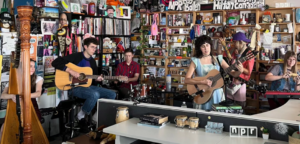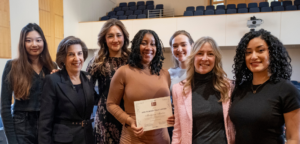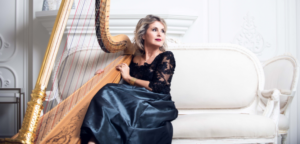Amy Thompson has been making waves as a composer (she recently won a BMI Student Composer Award), so Harp Column sat down with her to ask about her musical style and get some tips for how to work with composers writing for the harp.
What inspired you to start composing?
When I played piano as a child, I enjoyed improvising occasionally, and sometimes I memorized what I liked and wrote it down. I was always fascinated by the mystery of the unknown patterns behind music’s behavior, and in high school, my questions were answered when I began studying music theory through the Vanderbilt University’s Blair School of Music pre-college program. I began composing regularly and studying privately with a composition teacher at that time.
Can you tell us a little bit about your goals as a composer?
In all of my work, I wish to convey my sense of humor, optimism, and joy. Timbre and articulation are important elements to me, and my music tends to move in gestures rather than melodic phrases. I love thinking up non-standard structures (for instance, Somewhere to Elsewhere is in 6 movements, and only one of the movements uses a typical ABA form; the other movement’s structures are governed by recursive patterns of lengthening or shortening sections). At the same time, I continually repeat varied versions of the main musical material as to not leave the listener lost. My goal is to create music that is rewarding both for me, the player, and the listener.
Somewhere to Elsewhere, the piece that you submitted to the BMI Student Composer Awards, was for solo harp and ensemble. Do you write mostly for harp, or are you interested in moving away from writing harp music?
About half of my compositions involve the harp. While I enjoy writing music for the harp—it is, after all, the best instrument ever—I also want to learn how to write interesting, rewarding music for all instrumentalists to play, and I hope for my work to become established both inside and outside of the harp community.
Obviously, the harp can be a challenging instrument for composers. As both a harpist and composer, what are your thoughts on ways harpists can work with composers most effectively?
I find that too often harpists get caught up explaining what the harp can’t do compared to the piano rather than focusing on positive strategies for writing idiomatic harp music. I encourage harpists working with composers to meet the composer in person, and if possible, allow the composer to play around on the harp in order to personally feel how it works. It helps to have a few positive and negative examples of existing harp literature and to explain why a particular excerpt is bad or good. Remember that idiomatic harp writing doesn’t mean that the music is easy to perform; idiomatic writing means that the music plays to the instrument’s strengths (for instance, Ravel’s Introduction et Allegro).
I love this advice. Do you have any tips for harpists interested in starting to compose or arrange?
I encourage anyone wanting to compose or arrange to do a lot of listening, absorbing, imagining, and improvising before beginning writing. I find that starting with a half-formed idea in my head before I sit down to write (as opposed to coming in with nothing) actually helps me overcome potential limitations with my technical capabilities or slowness with my notation. Composing and arranging can be great ways to expand your technique and explore the full capability of the harp.
Any exciting projects or commissions in the works that you can share with us?
I’m currently in the beginning stages of a solo harp piece (inspired by the six-fold symmetry of snowflakes) as well as a piece for flute, saxophone, violin, and cello (for a workshop at a music festival I’m attending). After these projects, I have plans to begin writing a solo flute piece for a friend of mine and a harp quartet.
Anything else you’d like to add?
I encourage teachers of young students to incorporate composing and/or improvising into their lessons or assignments. In my experience, students are really excited by assignments as simple as “write a short piece about summer” or “write a melody with the whole tone scale” and consequently they become more interested both in the music they are playing and in understanding music theory.
To learn more about Thompson, check out her website at http://www.amyharp.com/.













